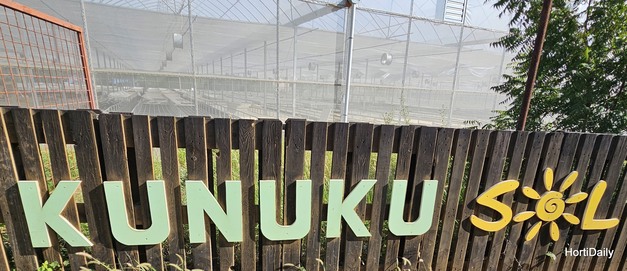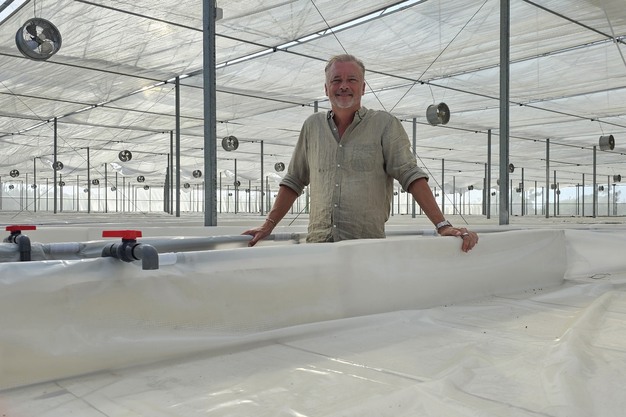Delivering 4,000 heads of lettuce daily to retail and catering outlets on the island is the goal of BonHydroponics, the latest project by Edward van Wonderen in Curaçao. Edward, a Dutchman with a background in football, shifted his entrepreneurial focus to the fresh produce sector nearly a decade ago. "The 5,500 m² greenhouse is already in place, as are the 130 hydroponic tables. Now we're just waiting for my grower from Bahrain to arrive, which will happen next week," Edward shares.
.jpg?preset=ContentFullSmall)

Each table holds about 800 heads of lettuce, translating to an annual yield of 1.3 million heads. Propagation is done in-house, with seeds tailored for hydroponics and Curaçao's tropical climate, sourced from Rijk Zwaan. Packaging materials for the lettuce are also imported from the Netherlands. "From seed to finished product, the entire process occurs here in the greenhouse," Edward explains.
"Batavia lettuce is supposed to be crisp"
Approximately 700 tons of leafy vegetables are imported into Curaçao each year. "There is some local lettuce cultivation, but it is small-scale and involves open-grown, heavier types. We grow gourmet lettuce in the high-end segment, with heads weighing 150 to 200 grams. This category, commonly found in resorts, restaurants, and retail, is currently grown in southern Italy, transported by truck to the Netherlands, packed there, flown to Curaçao, and delivered to wholesalers. That lettuce spends a week in transit, and it shows. Often, it arrives limp and unappealing, even though Batavia lettuce should be crisp.
"We offer fresh, unsprayed, and 'kilómetro cero' products—no transport emissions and a negative carbon footprint because the plants absorb CO2 as they grow," Edward says.
.jpg?preset=ContentFullSmall)

For Curaçao customers, buying lettuce grown at BonHydroponics is an easy choice, Edward argues. "Imported lettuce in supermarkets costs more than 5 guilders (€2.60) in Curaçao and $5 in Bonaire. Despite high local costs—water, electricity, and imported raw materials—we remain competitive with imported products and can sustain a profitable business. Launched in late 2022, the project involves 30 investors who can expect a solid return starting in 2025."

No competition for local growers
Lettuce consumption on the island is significant, as evidenced by the 700 tons of annual imports. "Our harvest aims to replace some of these imports. We are not competing with local growers but with Italian, and Dutch exporters, and airlines. By setting an example, we hope to encourage growth in the local horticulture sector, which is still small-scale. There is plenty of potential here."
The BonHydroponics greenhouse will employ eight to 10 local workers to manage the lettuce and prepare it for delivery. An experienced grower from Bahrain will train two assistants—one for Curaçao and another for Bonaire, where Edward is building a similar greenhouse. "In Bonaire, we've acquired a 1,500 m² greenhouse and are expanding it by 3,000 m², which will yield an additional 1 million heads of lettuce annually. A local supermarket has already expressed interest in purchasing the entire yield. Securing customers is not the challenge," Edward notes.

Automation and efficiency
The cultivation process relies on a mix of expertise and automation. Seawater, desalinated via reverse osmosis by utility provider Aqualectra, is cooled, UV-treated, and filtered before being distributed over the hydroponic tables. Excess water is collected, filtered, and reused. The system automatically monitors and adjusts nutrition, pH, and water temperature. "The 130 tables will support over 100,000 lettuce heads, consuming 8 to 10 cubic meters of water daily. Evaporation is minimal due to dense foam plates. This closed, circular system is a proven solution from Bahrain."

Comfortable working conditions
To manage greenhouse temperatures, shade cloths, 40 extractors, and 80 fans create a microclimate of 27°C above the tables, with water temperatures maintained at 22-24°C. "Without these measures, temperatures inside could reach 43°C. While plants could tolerate this, it would be uncomfortable for workers," Edward explains.
The greenhouse is enclosed with mesh to allow airflow while keeping insects out. The structure, made of galvanized steel, withstands wind gusts of up to 85 km/h. "Wind can be a challenge but also a cooling ally," he adds.

Minimizing disease pressure
Despite the humid, hot climate, Edward is confident in mitigating disease and pest risks. "The closed system, Rijk Zwaan seeds designed for hydroponics and tropical climates, and our sterile jute-based substrate from Holland BioProducts provide a solid foundation. Proper water quality and sterilization are critical. Challenges may arise, but we are committed to finding solutions without using chemical plant protection products."

Starting a business in Curaçao comes with unique challenges. "I'm a planner, but I've learned to let go of timelines here. Tasks like opening a bank account, registering with the Chamber of Commerce, and setting up utilities can take months, requiring multiple visits," Edward notes.

Customs visit
Customs also delayed progress by withholding "agri status," which exempts imported raw materials from taxes. "Although it was clear we were building a greenhouse for food production, they speculated it could be used for other purposes. This delayed tax exemptions worth €50,000, causing some sleepless nights. Thankfully, we were granted temporary agri status, with final approval expected after our first harvest."

Source of Inspiration
BonHydroponics aims to inspire other growers in the Caribbean. "The Dutch government has allocated €24 million for projects on Curaçao, Aruba, and Sint Maarten, providing a boost for initiatives like ours. Local regulations also promote self-sufficiency by banning imports of sufficiently available products, such as eggs. A similar approach for tomatoes, peppers, and leafy vegetables would be ideal, but the sector needs organization."

Edward plans to apply for subsidies to install solar panels, reducing dependency on the island's unreliable power grid. "Power outages can be a risk, but leafy vegetables have an eight-week growth cycle, limiting potential losses to two months."
Edward concludes, "This project not only meets local demand but sets the stage for a more self-reliant and sustainable horticulture sector in Curaçao."
BonHydroponics' lettuce will be on the shelves from next year in Curaçao under its own brand Fresku di Kòrsou, and in Bonaire with the brand Fresku di Boneiru.
For more information:
Edward van Wonderen
BonHydroponics
[email protected]
www.bonh ydroponics.com
Bonaire DailyFresh
[email protected]
www.bonairedailyfresh.com
